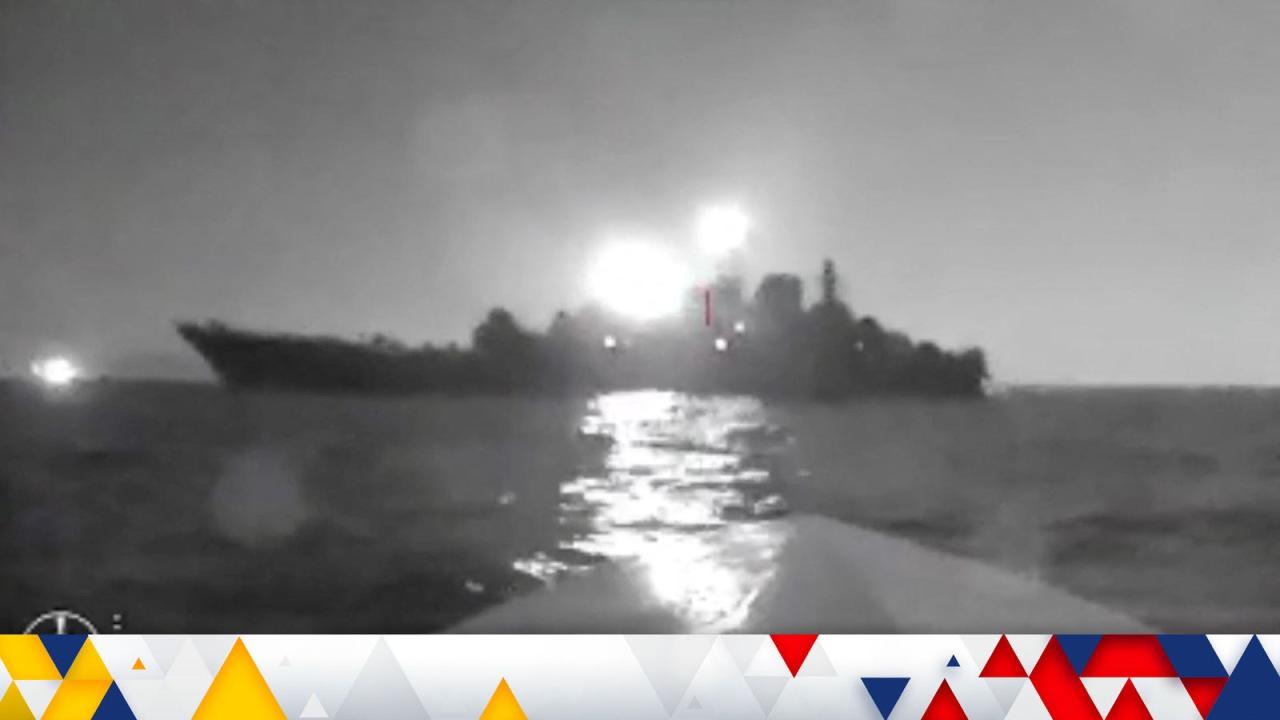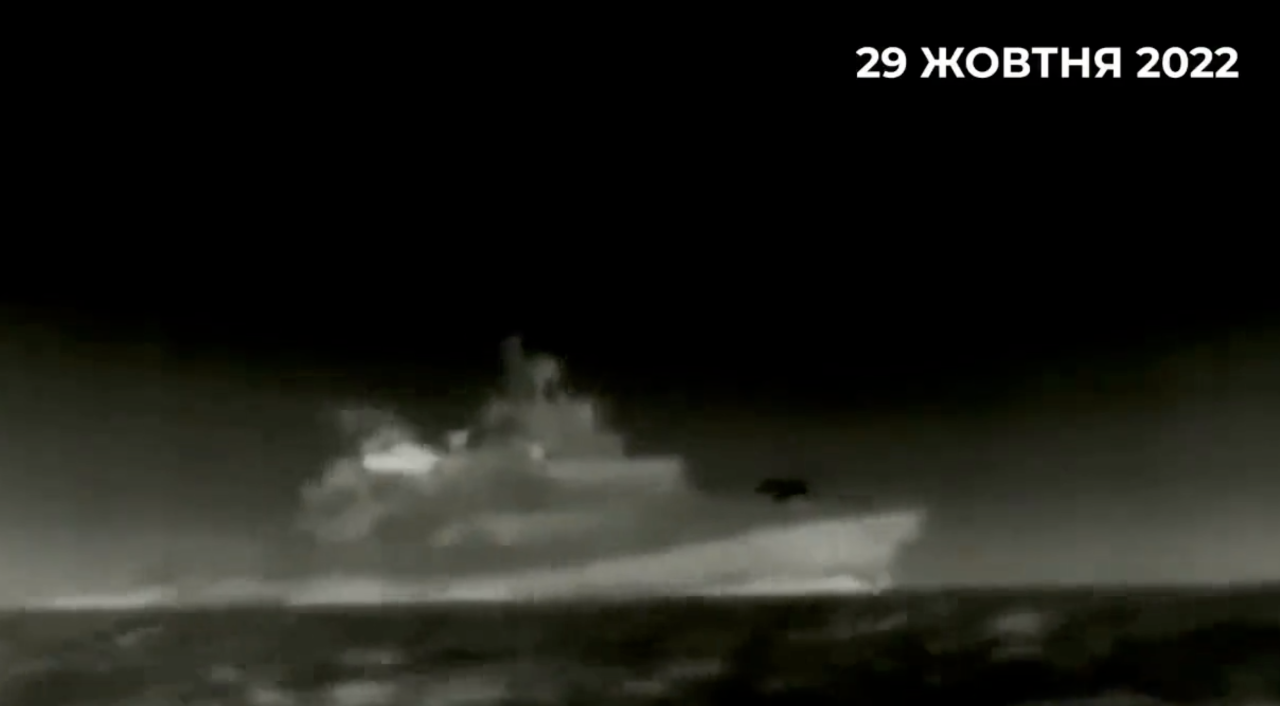Ukrainian sea drones are changing naval warfare. These unmanned vessels, ranging from small, expendable craft to more sophisticated autonomous systems, are proving surprisingly effective against larger, more expensive warships and coastal infrastructure. This exploration delves into their technology, deployment, impact, and future potential, offering a comprehensive look at this rapidly evolving area of military technology.
From their initial designs to their current battlefield applications, Ukrainian sea drones represent a cost-effective and adaptable tool in modern conflict. We’ll examine their construction, capabilities, and the strategic advantages they offer, alongside the logistical challenges and international implications of their use. We’ll also explore how their deployment has influenced naval doctrine and the potential for future development and proliferation.
Ukrainian Sea Drone Technology
Ukraine’s use of sea drones in the ongoing conflict has garnered significant international attention, showcasing a rapidly evolving and surprisingly effective naval capability. This technology, while relatively new, has significantly impacted naval warfare and international security discussions. This section details the characteristics, development, and comparison of Ukrainian sea drones with those of other nations.
Current State of Ukrainian Sea Drone Technology
Ukrainian sea drone technology currently encompasses a range of unmanned surface vessels (USVs) with varying capabilities. These drones are designed for diverse missions, including reconnaissance, surveillance, and offensive strikes against naval targets and coastal infrastructure. While precise details remain classified, reports suggest a mix of smaller, expendable drones and larger, more sophisticated systems capable of carrying heavier payloads and operating over longer ranges.
Evolution of Ukrainian Sea Drone Technology
The development of Ukrainian sea drone technology appears to have accelerated significantly since the start of the current conflict. Initial systems were likely simpler, focusing on basic reconnaissance and surveillance. However, through a combination of domestic innovation and adaptation of commercially available technology, Ukraine has rapidly advanced its capabilities, integrating more sophisticated navigation, communication, and targeting systems.
The conflict itself has served as a proving ground, leading to continuous refinement and improvement of the technology based on real-world operational experience.
Comparison with Other Nations’ Sea Drone Technology
Compared to established naval powers, Ukraine’s sea drone technology may lag in terms of overall sophistication and scale of production. However, Ukraine’s development demonstrates a remarkable capacity for rapid innovation and adaptation under pressure. The cost-effectiveness and relative simplicity of Ukrainian designs offer a significant advantage, allowing for the deployment of numerous drones in a swarm tactic, potentially overwhelming more advanced but less numerous adversary systems.
Materials and Components of Ukrainian Sea Drones
The construction materials and components of Ukrainian sea drones likely reflect a focus on affordability and readily available resources. Commercially available components are probably integrated where possible, while hull construction might utilize readily available materials like fiberglass or composite materials. The exact composition of the drones remains largely undisclosed for security reasons.
Ukrainian sea drones are making waves, showing how adaptable drone technology can be. Think about the sheer scale and precision of a coordinated drone display, like the amazing china new year’s drone show , and you can see the potential for similar, albeit more militarized, applications in maritime warfare. These unmanned vessels offer a cost-effective and versatile approach to naval operations, showcasing how drone tech continues to evolve.
Specifications of Ukrainian Sea Drone Models
| Model | Size (approx.) | Speed (approx.) | Payload (approx.) | Range (approx.) |
|---|---|---|---|---|
| Model A (Hypothetical) | Small, boat-like | 10-15 knots | 50-100 kg explosives | 50-100 km |
| Model B (Hypothetical) | Medium, larger hull | 15-20 knots | 100-200 kg explosives/reconnaissance equipment | 100-200 km |
| Model C (Hypothetical) | Large, multi-purpose | 20+ knots | 200+ kg various payloads | 200+ km |
| Model D (Hypothetical) | Small, expendable | 25+ knots | 25 kg explosives | 50 km |
Operational Deployment of Ukrainian Sea Drones
Documented instances of Ukrainian sea drone usage are often fragmented due to operational security. However, reports suggest successful attacks against various targets, highlighting their tactical value.
Documented Instances of Sea Drone Use
Reports indicate the use of Ukrainian sea drones in attacks on Russian naval vessels and coastal infrastructure. Specific details about targets and outcomes are often scarce, but the consistent reports suggest a pattern of effective, if low-profile, operations.
Tactical Advantages and Disadvantages of Sea Drone Deployment
The advantages of using sea drones include their low cost, relative ease of deployment, and the ability to overwhelm defenses through swarm tactics. Disadvantages include vulnerability to countermeasures, limited payload capacity in smaller models, and reliance on effective communication and navigation systems.
Logistical Challenges of Sea Drone Deployment
Deploying and maintaining sea drones in a conflict zone presents significant logistical challenges. These include ensuring reliable communication links, securing supply chains for replacement parts and ammunition, and managing the risk of loss or capture of valuable assets.
Hypothetical Scenario of Sea Drone Use
In a hypothetical scenario, a swarm of smaller, expendable Ukrainian sea drones could be used to saturate the defenses of a Russian naval base, while larger drones strike key infrastructure targets simultaneously, creating widespread disruption and damage.
Ukrainian sea drones are proving surprisingly effective in the conflict. Their low cost and adaptability make them a potent tool, and their tactics are constantly evolving, much like the games in the vip 3 squid game where strategic thinking is key to survival. Ultimately, the success of these drones, like the success in that game, hinges on innovation and clever deployment.
Potential Targets for Ukrainian Sea Drones
- Naval vessels (patrol boats, landing craft)
- Coastal infrastructure (fuel depots, power plants)
- Bridges and other critical infrastructure
- Enemy naval bases
- Command and control centers
Impact and Effectiveness of Ukrainian Sea Drones
Assessing the impact and effectiveness of Ukrainian sea drones requires considering various factors including target selection, environmental conditions, and the enemy’s response.
Factors Contributing to Success or Failure
Success hinges on accurate targeting, effective communication, and the ability to overwhelm enemy defenses. Failures may result from countermeasures, technical malfunctions, or environmental factors impacting drone operation.
Psychological Impact on Enemy Forces
The unpredictable nature and relative invisibility of sea drone attacks can have a significant psychological impact on enemy forces, inducing fear, uncertainty, and potentially degrading morale and operational effectiveness.
Influence on Naval Doctrine and Strategy

The effectiveness of Ukrainian sea drones has highlighted the potential of low-cost, asymmetric warfare capabilities in naval conflicts, influencing naval doctrines and strategies globally, prompting reevaluation of coastal defense strategies.
Potential for Future Development, Ukrainian sea drone
Future development could focus on increased autonomy, improved payload capacity, enhanced countermeasure resistance, and integration of advanced AI for improved decision-making and target acquisition.
Observed Effects of Ukrainian Sea Drone Attacks

| Target Type | Observed Damage | Operational Outcome | Assessment |
|---|---|---|---|
| Patrol Boat | Significant hull damage, partial sinking | Mission failure for the targeted vessel | High impact |
| Fuel Depot | Fire, significant fuel loss | Disruption of supply lines | High impact |
| Small Landing Craft | Minor damage | Minimal impact | Low impact |
International Implications of Ukrainian Sea Drone Use

The use of sea drones by Ukraine has far-reaching international implications, raising concerns about maritime security, the proliferation of autonomous weapons systems, and the legal and ethical dimensions of such technology.
Implications for International Maritime Security
The demonstrated effectiveness of Ukrainian sea drones raises concerns about the potential for increased use of such technology by various actors, both state and non-state, potentially destabilizing maritime environments globally.
Responses of Different Countries
The international response to the use of sea drones in the conflict has been varied, ranging from cautious observation to condemnation. Some countries express concern about the potential for escalation and the broader implications for autonomous weapons systems.
Potential for Proliferation
The relatively low cost and ease of production of some sea drone designs raise concerns about potential proliferation, increasing the risk of these technologies falling into the hands of non-state actors or less scrupulous nations.
Legal and Ethical Considerations
The use of autonomous weapons systems like sea drones raises complex legal and ethical questions, particularly concerning accountability for actions taken by these systems and the potential for unintended consequences.
Hypothetical Aftermath of a Successful Attack
Imagine a large Russian frigate, its deck ablaze, listing heavily to one side. A gaping hole, several meters wide, tears through the hull near the waterline, exposing mangled internal structures. Debris from the explosion, including twisted metal and shattered equipment, litters the surrounding water. Smoke billows from the stricken vessel, as crew members scramble to abandon ship, while the drone’s remains, a small, charred husk, floats nearby, a testament to its deadly effectiveness.
Future Developments in Ukrainian Sea Drone Technology
Future advancements in Ukrainian sea drone technology are likely to focus on enhancing autonomy, integrating AI, and developing countermeasures to enemy defenses.
Ukrainian sea drones are proving to be surprisingly effective, showcasing the power of smaller, more agile platforms in naval warfare. Thinking about the logistical challenges involved reminds me of the transportation needs of a large sports team, like the complexities involved in getting the Gonzaga basketball plane and its crew to away games. Back to the drones, though – their adaptability and relatively low cost are key factors in their effectiveness against larger, more expensive warships.
Potential Future Advancements
Future iterations will likely incorporate advanced AI for autonomous navigation, target recognition, and decision-making, improving effectiveness and reducing reliance on human operators. Improved materials and propulsion systems will likely enhance speed, range, and payload capacity.
Strategies for Countering Enemy Defenses
Strategies for countering enemy defenses might involve swarm tactics, decoys, electronic warfare, and the development of more resilient designs capable of withstanding countermeasures.
New Applications Beyond Military Use
Beyond military applications, Ukrainian sea drone technology could find use in commercial applications, such as oceanographic research, environmental monitoring, and infrastructure inspection.
Potential Technological Upgrades

- Improved AI for autonomous navigation and target recognition
- Enhanced propulsion systems for increased speed and range
- More resilient materials and designs to withstand countermeasures
- Integration of advanced sensors and communication systems
- Development of specialized payloads for various missions
Concept for a Next-Generation Sea Drone
This next-generation sea drone, designated “Neptune-X,” would be a modular, multi-role platform capable of carrying a variety of payloads, including high-explosive warheads, reconnaissance equipment, and electronic warfare systems. It would feature advanced AI for autonomous operation, enhanced stealth capabilities, and improved countermeasure resistance. The modular design would allow for easy adaptation to different mission requirements, while advanced propulsion would enable high speeds and extended operational range.
Ending Remarks
Ukrainian sea drones have undeniably disrupted naval warfare, demonstrating the potential of unmanned systems to level the playing field. Their effectiveness highlights the need for innovative countermeasures and raises crucial questions about international maritime security and the future of autonomous weaponry. As technology continues to advance, the role and impact of these drones will only grow, making their study essential for understanding the evolving landscape of naval power.
FAQ Explained
What types of payloads can Ukrainian sea drones carry?
Payloads vary depending on the drone model, but can include explosives, sensors for reconnaissance, and electronic warfare equipment.
How are Ukrainian sea drones guided and controlled?
Control methods range from pre-programmed routes to real-time operator control via satellite or other communication links, with varying degrees of autonomy.
What are the limitations of Ukrainian sea drones?
Limitations include range, vulnerability to countermeasures (like electronic warfare or anti-drone systems), and dependence on reliable communication links.
How does the cost of Ukrainian sea drones compare to traditional naval vessels?
They are significantly cheaper to produce and deploy than traditional warships, making them a cost-effective option for asymmetric warfare.
